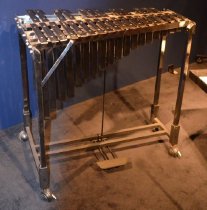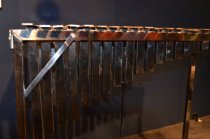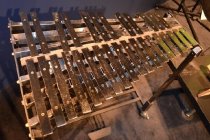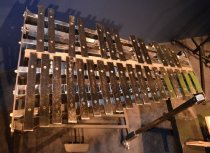Object Record
Images




Metadata
Catalog Number |
1999.07.01 |
Object Type |
Vibraphone |
Creator |
Musser, Clair Omar |
Title |
Celestaphone |
Description |
Celestaphone is a vibraphone made from steel formed out of meteoritic material. 2.5 octaves (G-C), one sustaining pedal. Square resonators, frame is removable from wheel base, but pedal is attached. Held together by stock furniture screws and cap nuts. Bars are mounted to frame via rubber mounts that resemble a roof with a chimney. Undersides of some bars are pitted for tuning. Two cracks on frame: One in back support section on the low end, and one in front section at upper end. |
Dimensions |
H-28 W-23 L-32.25 inches |
People |
Musser, Clair Omar |
Date |
1977 |
Additional Research |
Inspired by Halley's Comet, the Celestaphone was constructed by Clair O. Musser as a combination of his interests in music, astronomy, meterorology, metallurgy, meteoritics, acoustics, musical physics, and holography. Musser collected over 1,388 pounds of meteorites and used 678 pounds from his collection to manufacture this one-of-a-kind Celestaphone. In addition to the 30 "Meteoritic Tone Bars," over 353 parts were machined for the resonators, frane, and other portions of the instrument. Except for the bolts, all metal parts of the instrument are of meteoric metal. Tuned to A-440, it has a 2 1/2 octave range, G to C. Due to the long sustain of the bars, there is a pedal for muffling the instrument. It can be played with mallets or bowed for music that truly sounds, "celestial."-Rhythm! Scene, August 2014. The "Celestaphone Story" is an unparalleled account of 20th Century Scientific Endeavor and Technological Achievement. It is the culmination of "A Boyhood Dream" and the rewarding fruition of Astronomical research and musical Physics. The Celestaphone is a "concert grand" percussive musical instrument exclusively fabricated of rare "metal meteorites." Its musical range encompasses the chromatic scale from lowest Violin G to the 1,000-cycle C above the treble clef. Four decades of "Siderite Collecting" from the four corners of the earth yielded 1,388 pounds of rare "Space Metals." Six hundred seventy eight pounds of this exotic material was appropriated for this unprecedented program. The ultimate "Scientific Analysis Techniques" in contemporary "Meteoritical Research" were practiced with Space Age Technology. The unique talents of a distinguished Meteoriticist Metallurgist Scientist Acoustician guided the success of this endeavor. More than 100 "Technological Specialists" in Metallurgy, Physics, Holography and Nucleonics assisted in this 15 year program. Following the "Scientific Research" chronology, the Meteorites were classified for "induction melting and casting." Specimens containing the largest amounts of Nickel and harder elements were alloyed for the keyboard "Tone Bars." Cast units were then cut, ground, machined, welded, fabricated, polished, epoxied, oven baked and assembled. In addition to the Celestaphone's 30 "Meteoritic Tone Bars," 331 instrument and resonator tube parts were meticulously fabricated. This five billion year metal from the orbits of Jupiter and Mars conducted an unprecedented ethereal musical voice...Meteoritical Science is barely three half centuries old, but the knowledge of these heavenly objects reaches far into the distant past. Long before man learned to smelt iron from its ores, he used "Meteoritic Iron" to produce various artifacts. Researching languages, we find that the word iron is related to the words Sky and Star....in Ancient Egypt, the word Iron meant "Metal from Heaven." Researching five thousand years of history, we learn that Meteorites always commanded "front-page" attention thru-out man's progress. Worshipped as Heavenly Messengers, adornment for the Queens of Egypt, Meteorites were also Anvils, Plow shares, Tools, Knives, Daggers and Swords. Many of the "Celestaphone's Meteorites" are resplendent in their very own, unique, "earthly heritages." Signally, the ethereal tones of the Celestaphone's highest (F and A) "Tone Bars" are voices of the SikhoteAline Meteorite, presented to Musser by the USSR, February 16, 1960. The Republic of the Philippines "Atomic Energy Commission" contributed a Siderite to the Celestaphone program, February 23, 1962. This rare Luzon Ataxite contained Iron, 17% Nickel, and surprising amounts of Cobalt, Phosphorus and Carbon. The Celestaphone's "middle C Tone Bar" voices a unique "Chinese Hexahedrite" acquired by Musser in Taipei, November 17, 1961. Another Historic Siderite complements the "treble octave," acquired in 1936 from descendants of Kit Carson, who ceremoniously received the Meteorite from the Indian Chief Yellow Dog. Other Celestaphone voices which ring from Meteorites, Greenland, Antarctica, Mexico, Japan, France, Canada, Wales, Guatemala and Chile. "Seventy seven" of these verifiable Space visitors contributed to the creation of this "Celestially Voiced" instrument. More than a hundred pounds of the World Famous "Arizona Siderites" recovered near the giant Winslow Crater radiate in the Celestaphone. These Arizona Meteorites contain Iron, Nickel, Cobalt, Carbon, Silicon, Sulphur, Phosphorous, Platinum, Iridium, Gold, Silver and Diamonds. To hear the music of this instrument takes you back "Five Billion" years to the Genesis of the Solar System. The Celestaphone is an "Astro-Meteoritic Voice Composite." Truly, "Music From Out of this World." (Article, written by Clair Musser, published in the April 1999 edition of Percussive Notes.) This vibraphone, with 30 tone bars and over 353 parts, was made from 678 pounds of meteorites. Inspired by Halley's Comet, percussionist and composer Clair Omar Musser worked with more than 100 technological specialists over 15 years to create this innovation. This celestial instrument has a 2 ½ octave range, G to D, and produces a long sustained sound from the bars, which can be easily muffled by the damper pedal. The capable performer can draw sounds that feel otherworldly. Evolving Sounds, 2017. Celestaphone Designed and Assembled by Clair Omar Musser 1977 The Musser Celestaphone is a member of the vibraphone family of instruments. Its design includes a damper pedal but neither rotary fans nor motor to drive them. A man of both musical and scientific talents, Clair Musser began collecting meteorites in 1936. After four decades, he eventually acquired over 1,388 pounds of this rare, five-billion-year-old space material originating from the orbits of Jupiter and Mars. He sent 678 pounds of his meteoritic collection to a foundry where the material was melted at temperatures approaching 6,200F. From this material, 30 "Meteoritic Tone Bars" were forged, together with 331 additional pieces machined to produce the resonators, frame and other parts. This instrument weighs 83 pounds. It has a 2 1/2-octave range beginning with the G below middle-C. It can be played with mallets, or the bars can be caused to vibrate by drawing a violin bow along their edges. Donated by Perry and Nancy Preusch PAS Museum Exhibit Label |
Related Objects |
Show Related Records... |
Credit line |
Gift of Nancy and Perry Preusch |
